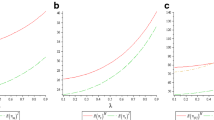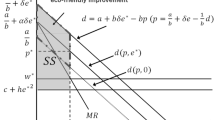Abstract
In this paper, we investigate a manufacturer’s encroachment decision in a dual-channel supply chain with substitutable green products. The manufacturer makes green investment and pricing decisions and sells through its own retail store as well as an independent retailer. We make a major contribution by incorporating consumer green awareness as well as product competition into game-theoretic models of the dual-channel supply chain. Specifically, we explicitly analyze the impacts of consumer green awareness and product substitutability on profitability, social welfare, and environmental performance of the supply chain and its firms. Our main findings include the followings. First, with encroachment, higher consumer green awareness and product substitutability always benefit the manufacturer. However, they benefit the retailer only when the manufacturer encroachment cost is sufficiently high. Second, for the green manufacturer, the encroachment strategy can outperform the no-encroachment strategy in terms of profitability, social welfare, and environmental performance. We also employ numerical examples to further illustrate our analytical findings and gain more managerial and policy insights.



Similar content being viewed by others
References
Accenture. More than one-third has no awareness of level of emissions in their supply chain network, 2009. https://newsroom.accenture.com/article_display.cfm?article_id=4801.
Ahmad, R., Farzad, D., Behnam, F., et al. (2017). Green supply chain network design with stochastic demand and carbon price. Annals of Operations Research, 250(2), 463–485.
Altug, M. S. (2016). Supply chain contracting for vertically differentiated products. International Journal of Production Economics, 171, 34–45.
Aysegul, T., & Bilgesu, C. (2017). How supply chain coordination affects the environment: A carbon footprint perspective. Annals of Operations Research, 250(2), 487–519.
Bai, C., Dhavale, D., & Sarkis, J. (2016). Complex investment decisions using rough set and fuzzy c-means: An example of investment in green supply chains. European Journal of Operational Research, 248(2), 507–521.
Chen, C. K., & Ulya, M. A. (2019). Analyses of the reward-penalty mechanism in green closed-loop supply chains with product remanufacturing. International Journal of Production Economics, 210, 211–223.
Chen, J., Liang, L., & Yao, D. (2019). Factory encroachment and channel selection in an outsourced supply chain. International Journal of Production Economics, 215, 73–83.
Chen, K. Y., Kaya, M., & Ozer, O. (2008). Dual sales channel management with service competition. Manufacturing & Service Operations Management, 10(4), 654–675.
European Commission. Attitudes of Europeans citizens towards the environment. Eurobarometer, 2008, 295. http:// www.ec.europa.eu/public_opinion/archives/ebs/ebs_295_en.pdf.
Conrad, K. (2005). Price competition and product differentiation when consumers care for the environment. Environment and Resource Economics, 31, 1–19.
Du, S. F., Tang, W. Z., Zhao, J. J., et al. (2018). Sell to whom? Firm’s green production in competition facing market segmentation. Annals of Operations Research, 270(1–2), 125–154.
Dumrongsiri, A., Fan, M., Jain, A., & Moinzadeh, K. (2008). A supply chain model with direct and retail channels. European Journal of Operational Research, 187(3), 691–718.
Fattahi, M., & Govindan, K. (2017). Integrated forward/reverse logistics network design under uncertainty with pricing for collection of used products. Annals of Operations Research, 253(1), 193–225.
Frostenson, M., & Prenkert, F. (2015). Sustainable supply chain management when focal firms are complex: A network perspective. Journal of Cleaner Production, 107, 85–94.
Gao, J., Xiao, Z., Wei, H., et al. (2018). Active or passive? Sustainable manufacturing in the direct-channel green supply chain: A perspective of two types of green product designs. Transportation Research Part D, 65, 332–354.
Govindan K., Sarkis J., Jabbour C.J.C., Zhu Q, Geng Y. Eco-efficiency based green supply chain management: Current status and opportunities. European Journal of Operational Research 2014, 233(2): 293–298.
Hafezalkotob, A. (2015). Competition of two green and regular supply chains under environmental protection and revenue seeking policies of government. Computers & Industrial Engineering, 82, 103–114.
Hafezalkotob, A. (2017). Competition, cooperation, and coopetition of green supply chains under regulations on energy saving levels. Transportation Research Part E Logistics Transportation Review, 97, 228–250.
Haytko, D. L., & Matulich, L. (2011). Green advertising and environmentally responsible consumer behaviors: Linkages examined. Jounal of Management and Marketing Research, 1, 2–11.
Hervani, A. A., Helms, M. M., & Sarkis, J. (2005). Performance measurement for green supply chain management. Benchmark. and International Journal, 12, 330–353.
Heydari, J., Govindan, K., & Aslani, A. (2019). Pricing and greening decisions in a three-tier dual channel supply chain. International Journal of Production Economics, 217, 185–196.
Hong, Z., & Guo, X. (2019). Green product supply chain contracts considering environmental responsibilities. Omega, 83, 155–166.
Jamali, M. B., & Rasti-Barzoki, M. (2018). A game theoretic approach for green and non-green product pricing in chain-to-chain competitive sustainable and regular dual-channel supply chains. Journal of Cleaner Production, 170, 1029–1043.
Kök, G. A., Fisher, M., & Vaidyanathan, R. (2009). Assortment planning: Review of literature and industry practice. Retail supply chain management. International Series in Operations Research & Management Science, 122, 1–55.
Krass, D., Nedorezov, T., & Ovchinnikov, A. (2013). Environmental taxes and the choice of green technology. Production and Operations Management, 22(5), 1035–1055.
Lei, H., Wang, J., Yang, H., et al. (2020). The impact of ex-post information sharing on a two-echelon supply chain with horizontal competition and capacity constraint. Annals of Operations Research. https://doi.org/10.1007/s10479-020-03598-5
Li, B., Zhu, M., Jiang, Y., & Li, Z. (2016). Pricing policies of a competitive dual-channel green supply chain. Journal of Cleaner Production, 112, 2029–2042.
Li, G., Lim, M. K., & Wang, Z. (2020a). Stakeholders, green manufacturing, and practice performance: Empirical evidence from Chinese fashion businesses. Annals of Operations Research, 290(1–2), 961–982.
Li, J., Yang, S., Shi, V., & Zhai, S. (2020b). Partial vertical centralization in competing supply chains. International Journal of Production Economics, 224(107565), 1–13.
Li, J., Yi, L., and Shi, V., et al. Supplier encroachment strategy in the presence of retail strategic inventory: Centralization or decentralization? Omega 2021, 98, 102213.
Li, L., & Zhang, H. (2008). Confidentiality and information sharing in supply chain coordination. Management Science, 54(8), 1467–1481.
Li, P., Rao, C., Goh, M., Yang, Z. Pricing strategies and profit coordination under a double echelon green supply chain. Journal of Cleaner Production 2020, In press, 123694.
Li, T. T., Xie, J. X., & Zhao, X. B. (2015). Supplier encroachment in competitive supply chains. International Journal of Production Economics, 165, 120–131.
Liu, B., & Pietro, D. G. (2019). Green process innovation through Industry 4 0 technologies and supply chain coordination. Annals of Operations Research. https://doi.org/10.1007/s10479-019-03498-3
Liu, Y., Li, J., Ren, W., et al. (2020). Differentiated products pricing with consumer network acceptance in a dual-channel supply chain. Electronic Commerce Research and Applications, 39,
Liu, Z., Anderson, T. D., & Cruz, J. M. (2012). Consumer environmental awareness and competition in two-stage supply chains. European Journal of Operational Research, 218, 602–613.
Manez, J.A., Waterson, M. (2001) Multiproduct firms & product differentiation: A survey University of Warwick Economics Department Working Paper No. 594, U.K: Warwick.
Martinez, E. Eco friendly fashion. 2010. http://www.eco- friendly- digest.com/ eco- friendly- fashion.html.
Meng, J. Buying air conditioners online has become a fun task. China Daily 2016. http://www.chinadaily.com.cn/ business/tech/ 2016–07 /04/content_25951639.htm.
Moorthy, K. S. (1984). Market segmentation, self-selection, and product line design. Marketing Science, 2, 288–308.
Moriarty, R. T., & Moran, U. (1990). Managing hybrid marketing systems. Harvard Business Review, 68(6), 146.
Mussa, M., & Rossen, S. (1978). Monopoly and product quality. J. Econ. Theory, 18, 310–317.
Nagurney, A., & Li, D. (2015). A supply chain network game theory model with product differentiation, outsourcing of production and distribution, and quality and price competition. Annals of Operations Research, 226(1), 479–503.
Palevich, R. The lean sustainable supply chain: How to create a green infrastructure with lean technologies. Ft Press, 2012.
Patra, P. (2018). Distribution of profit in a smart phone supply chain under green sensitive consumer demand. Journal of Cleaner Production, 192, 608–620.
Pietro, D. G. (2014). Environmental collaboration in a closed-loop supply chain with a reverse revenue sharing contract. Annals of Operations Research, 220(1), 135–157.
Radhi, M., & Zhang, G. (2019). Optimal cross-channel return policy in dual-channel retailing systems. International Journal of Production Economics, 210, 184–198.
Rajagopalan, S., & Xia, N. (2012). Product variety, pricing and differentiation in a supply chain. European Journal of Operational Research, 217, 84–93.
Ranjan, A., & Jha, J. K. (2019). Pricing and coordination strategies of a dual-channel supply chain considering green quality and sales effort. Journal of Cleaner Production, 218, 409–424.
Saha, S., Sarmah, S. P., & Modak, N. M. (2018). Single versus dual-channel: A strategic analysis in perspective of retailer’s profitability under three-level dual-channel supply chain. Asia Pacif. Manag. Review, 23(2), 148–160.
Shao, X. F. (2013). Integrated product and channel decision in mass customization. IEEE Transactions on Engineering Management, 60(1), 30–45.
Syam, N. B., Ruan, R., & Hess, J. D. (2005). Customized products: A competitive analysis. Marketing Science, 24(4), 569–584.
Taleizadeh, A. A., Kannan, G., & Nasim, E. (2020). The effect of promotional cost sharing on the decisions of two-level supply chain with uncertain demand. Annals of Operations Research, 290(1), 747–781.
Tsay, A. A., & Agrawal, N. (2004). Channel conflict and coordination in the ecommerce age. Production and Operations Management, 13(1), 93–110.
Turken, N., Carrillo, J., & Verter, V. (2020). Strategic supply chain decisions under environmental regulations: When to invest in end-of-pipe and green technology. European Journal of Operational Research, 283(2), 601–613.
Wang, X., & Ng, C. T. (2020). New retail versus traditional retail in e-commerce: Channel establishment, price competition, and consumer recognition. Annals of Operations Research, 291(1–2), 921–937.
Xia, N., & Rajagopalan, S. (2009). A competitive model of customization with lead-time effects. Decision Sciences, 40(4), 727–758.
Xiao, T., Choi, T. M., & Cheng, T. C. E. (2014). Product variety and channel structure strategy for a retailer-Stackelberg supply chain. European Journal of Operational Research, 233(1), 114–124.
Xu, H., Liu, Z. Z., & Zhang, S. H. (2012). A strategic analysis of dual-channel supply chain design with price and delivery lead time considerations. International Journal of Production Economics, 139(2), 654–663.
Yang, D., Xiao, T., & Huang, J. (2019). Dual-channel structure choice of an environmental responsibility supply chain with green investment. Journal of Cleaner Production, 210, 134–145.
Yenipazarli, A. (2017). To collaborate or not to collaborate: Prompting upstream eco-efficient innovation in a supply chain. European Journal of Operational Research, 260(2), 571–587.
Yoon, D. H. (2016). Supplier encroachment and investment spillovers. Production and Operations Management, 25(11), 1839–1854.
Zhang, J., Li, S., Zhang, S., & Dai, R. (2019). Manufacturer encroachment with quality decision under asymmetric demand information. European Journal of Operational Research, 273(1), 217–236.
Zhang, L., Wang, J., & You, J. (2015). Consumer environmental awareness and channel coordination with two substitutable products. European Journal of Operational Research, 241(1), 63–73.
Zhang, S., & Zhang, J. (2020). Agency selling or reselling: E-tailer information sharing with supplier offline entry. European Journal of Operational Research, 280(1), 134–151.
Zhu, Q., Sarkis, J., & Lai, K. (2012). Examining the effects of green supply chain management practices and their mediations on performance improvements. International Journal of Production Research, 50, 1377–1394.
Acknowledgements
Dr. Li’s research is supported by the National Social Science Foundation of China (19BGL194); Zhejiang Provincial Natural Science Foundation of China (LY20G020006); the Fundamental Research Funds for the Provincial Universities of Zhejiang (JR202102). Dr. Shi is supported by Natural Sciences and Engineering Research Council of Canada (Grant # 213090). Dr. Zhu is supported by the National Natural Science Foundation of China (No. 71771188) and the Fundamental Research Funds for the Central Universities (No. JBK18JYT02, JBK1805008 and JBK190504). The authors are listed alphabetically and contribute equally.
Author information
Authors and Affiliations
Corresponding author
Additional information
Publisher's Note
Springer Nature remains neutral with regard to jurisdictional claims in published maps and institutional affiliations.
Appendices
Appendix
Proof of Lemma 1
Under the no-encroachment strategy, the game is solved using backward induction. At stage 1, solving (6) yields the equilibrium wholesale price \(w^{N}\) and green level \(g_{r}^{N}\) in the following:
\(w^{N} = \frac{a}{2} + \frac{{3Ht^{2} }}{4}\), \(g_{r}^{N} = tH\).
Plugging these values of \(w^{N}\) and \(g_{r}^{N}\) into Eq. (5), we thus obtain the equilibrium retail price:
\(p_{r}^{N} = \frac{{3a}}{4} + \frac{{7Ht^{2} }}{8}\).
Substituting them again into (4) and (6), we have the equilibrium profits:
\(\Pi _{m}^{N} = \frac{{(2a + Ht^{2} )^{2} }}{{32}}\) and \(\Pi _{r}^{N} = \frac{{(2a + Ht^{2} )^{2} }}{{64}}\). □
Rights and permissions
About this article
Cite this article
Li, J., Liang, J., Shi, V. et al. The benefit of manufacturer encroachment considering consumer’s environmental awareness and product competition. Ann Oper Res (2021). https://doi.org/10.1007/s10479-021-04185-y
Accepted:
Published:
DOI: https://doi.org/10.1007/s10479-021-04185-y




